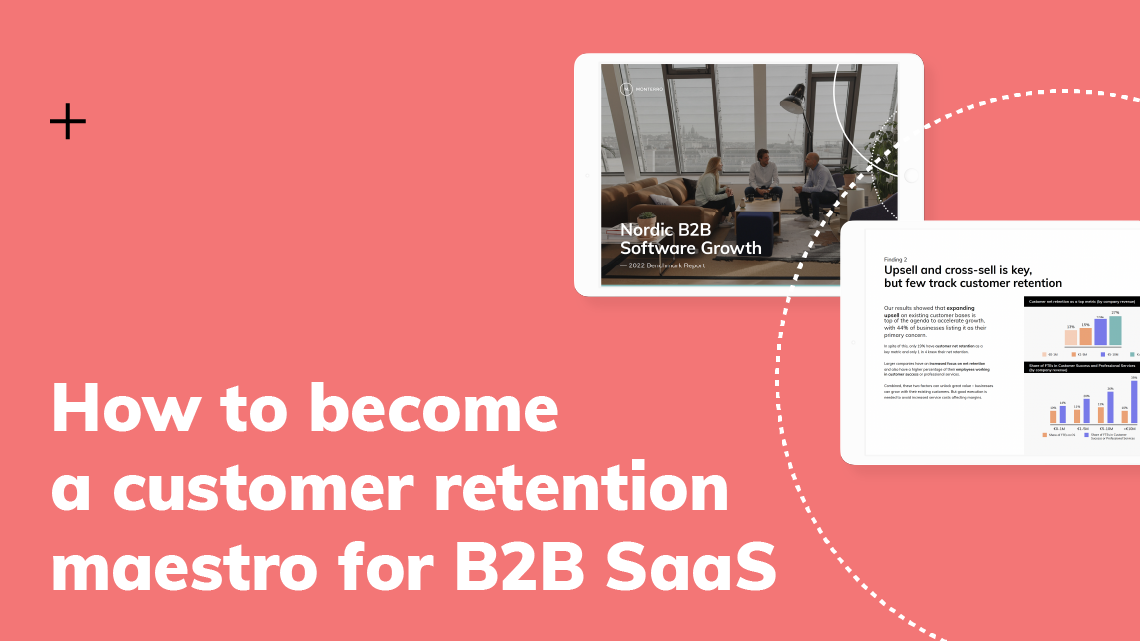How to make most of the customers you’ve already got on your plate.
Growth doesn’t always mean new customers – it can mean maximising the deals with the customers you already have. To help you, we’ve outlined four customer success top tips so you can become a retention maestro.
Nordic B2B software companies are beginning to understand that. In fact, 44% of the businesses we surveyed in our 2022 Nordic B2B Software Growth Benchmark Report, placed expanding upsell on existing customer bases at the top of the agenda.
But in spite of this, just 19% have customer net retention as a key metric, and only a quarter of people knew their net retention (and that’s a problem).
Upsell and cross-sell opportunities need to be earned through customer satisfaction. And if you’re not rigorously measuring your customer retention performance, how can you really know how satisfied your customers are? Or make adequate growth predictions for your business?
It’s also not as simple as just adding customer net retention as a metric. You’ll need to combine rigorous measurement with a robust customer success program to ensure you can deliver sustained value to your customers.
This is particularly important for SaaS companies.
The B2B SaaS business model often requires you to invest in customers before you’ve actually acquired them. To get a return on that investment, you need to deliver value so you can retain customers and lower your churn rate.
But how can you make sure your customer success program is, well, successful?
Define your roles for customer retention
First, map out all the steps your customers will go through with your product – from purchasing right through to renewal. Then draw up clear lines of responsibility and accountability within your Customer Success team – everyone should know who will cover each part of the process.
It’s vital that adoption is a key responsibility here. Once you’ve made a sale, you need to get your customer to actually use your software. Don’t just assume a new customer will start using your software, make sure someone in the team is accountable for making sure they do.
This culture of accountability should permeate the entire organisation. Draw up a clear division of responsibilities between the sales team and CSM team e.g. who is responsible to upsell/cross-sell. You’ll also need to know your chain of command, who answers to who, and who has the final say?
This helps drive retention by decreasing (and ideally eliminating) the gaps a customer can fall into. If your teams know the process, and take ownership over their part of it, you can improve customer experience and ultimately increase the likelihood of them renewing.
Segment your customers
Understanding how valuable each customer is to you is vital.
As you develop a strong customer success culture within your organisation, there will be a tendency to want to help every customer equally. But to make your CS wins scalable, you’ll need to segment your customers. Base this segmentation on how big a customer they are to you, their growth potential, and the Annual Contract Value (ACV).
Hire well
Teams are only as good as the people staffing them and with customer retention, those teams need to work really well together.
For example, the sales team might land a new customer, but the journey to winning their hearts is just the beginning. This is why it’s vital you hire a good Customer Success Manager.
A good Customer Success Manager (CSM) has a “farmer” quality. Their ultimate goal is to create lifelong customers by overseeing support through everything from onboarding and adoption, through to renewal. But they’ll also need to close deals, identify new business opportunities, and hit targets.
The best hire for a CSM is someone proactive who knows how to solve problems before they happen. The key is to look for people who have an innovative mindset, and not just focus on those who are good at forming relationships.
Use data
Don’t forget the power of crunching the numbers. First up make sure you draw up a customer health scorecard. This is a metric used to assess whether customers are healthy or at-risk of churn and will be subjective depending on what’s important to your organisation. Using customer health scorecards helps you streamline and standardise the selling process, which should inform decision making and help identify any issues early on.
And of course, don’t forget net revenue retention. It measures the overall impact on revenue generation from your existing customers. Just a slight change in net revenue retention can result in big numbers in the long term. It’s best to strive for a net revenue retention rate above 100%.
And that’s it.
If you want to get your hands on more customer retention insights, take a look at our Nordic B2B Software Growth Benchmark Report or get our Customer Success ebook here.

